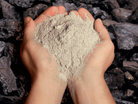Eco Materials Technologies Charts Sustainable Construction

A report from one of North America’s largest eco buildings-materials tech companies stresses the importance of the global construction industry of moving to greener options around cement.
The paper, from Eco Materials Technologies (EMT) outlines how concrete is the world’s most heavily used man-made material, with 10 billion tons of it produced globally.
EMT is a leading provider of zero and near-zero carbon supplementary cementitious materials (SCMs).
One SCM is fly ash, a fine powder produced from burning coal in power plants, and that is used in concrete, enhancing strength and durability while reducing environmental impact.
Fly ash is transported to ready-mix concrete production plants and is
held in storage terminals on-site, at the site to be added into mixtures.
Through fly ash innovation, EMT is looking to promote environmental sustainability on a global scale.
The report highlights how innovative materials designed to reduce the cement industry's substantial CO2 emissions are affecting significant change in the construction sector by:
- Providing sustainable alternatives to traditional cement
- Reducing the industry's carbon footprint
- Addressing global cement shortages
- Promoting circular economy principles in construction
Fly ash transforming the concrete and cement markets
Eco Material Technologies aims to revolutionise the US cement industry with its proprietary technology, targeting replacement of a significant portion of the country's 100 million metric tons annual portland cement production.
The company's products currently substitute 20-100% of cement use, with plans to double greenhouse gas emission savings to 12 million metric tons annually by 2030.
Eco's patented process creates a superior, more durable cement alternative that fits seamlessly into existing industry practices while leveraging their extensive distribution network to disrupt the market.
Growing public awareness and regulatory support are accelerating Eco's environmental initiatives.
Additionally, highlighting the importance of sustainability to stakeholders, in 2023, Eco Material carried out an assessment to identify the ESG topics that are most key to businesses.
It found that what influenced stakeholder assessments and decisions the most, is: employee health and safety, beneficial use of recovered material, then greenhouse gas emissions.
By repurposing this waste material, EMT is not only reducing landfill waste but also providing a sustainable alternative to traditional cement in concrete production.
The company's innovative approach involves harvesting fly ash from both operating coal plants and landfills, effectively turning an environmental liability into a valuable construction resource.
This process significantly reduces the carbon footprint associated with concrete production, as fly ash requires less energy to produce compared to traditional cement.
Global distribution of sustainable materials
EMT's influence extends beyond the US, with the company actively exploring opportunities in international markets.
Their global distribution network ensures that sustainable construction materials are accessible worldwide, addressing the growing demand for eco-friendly building solutions.
The company's innovative products currently substitute 20-100% of cement use, with plans to double greenhouse gas emission savings to 12 million metric tonnes annually by 2030.
EMT's patented process creates a superior, more durable cement alternative that fits into existing industry practices.
Its extensive distribution network positions them to disrupt the cement market significantly.
The company's efforts are bolstered by increasing public awareness and regulatory support for environmental, social and governance initiatives.
EMT's cost-efficient and stronger products offer greater longevity, requiring less frequent replacement and contributing to a more sustainable construction sector.
Sustainable products and case studies
EMT's product range includes green cement and natural pozzolans, which offer superior performance while reducing environmental impact.
Green cement being an eco-friendly alternative to traditional cement, while natural pozzolans are volcanic materials enhancing concrete's strength and durability.
The company's innovative approach to fly ash harvesting and beneficiation has also transformed the environmental liability of concrete into a valuable construction resource.
Some outcomes from EMT’s sustainable products include:
- ‘6.5 million short tonnes of fresh fly ash and bottom ash, diverted from landfills, in 2023’
- ‘85,000 tons of natural pozzolan sold and 67,600 metric tonnes of CO2 avoided, in 2023’
- ‘355,000 tons of fresh fly ash harvested for beneficial use and 278,600 metric tonnes of CO2 avoided, in 2023’
- ‘69,000 tonnes of green cement produced and over 50,000 metric tons of CO2 avoided by utilising green cement, in 2023’
A case study example from utilising SCM from Eco Materials is 3D printed homes.
In 2023, EMT partnered with Hive3D, a home-building company that uses advanced 3D printing technology, to create 3D-printed homes using a mortar-like ink that replaces 50-100% of ordinary portland cement with eco materias.
By incorporating locally sourced aggregates, EMT optimised the home-building process, reducing costs and carbon footprint.
Rob McNally, CGO & EVP for EMT says: “If the cement industry were a country, it would rank as the third-largest emitter of car-bon dioxide (CO2) globally, responsible for approximately 8% of worldwide CO2 emis-sions.
“These statistics not only highlight the scale of our challenge but also under-score the need for change within our sector.”
He continues: “We are committed to expanding our sources of SCMs and building new near-zero-carbon product operations to meet our growth objectives and maintain our aim to significantly reduce the demand for ordinary portland cement (OPC).
“Our innovative solutions have already replaced 5% of U.S. cement production, preventing over 5.9 million metric tons of CO2 emissions annually.”
He concludes: “By 2030, we aim to double our impact in North America, leading
the market in near-zero-carbon concrete products.”
******
Make sure you check out the latest news at Construction Digital, a BizClik brand.
- Trackunit: the Future of Technology & AI for ConstructionTechnology & AI
- Balfour Beatty Bolsters Digital and Procurement LeadershipProject Management
- Tarmac Sustainability Report: Green Strides for ConstructionSustainability & Green Building
- Urbanisation ‘Driving Concrete and Cement Growth’Built Environment




